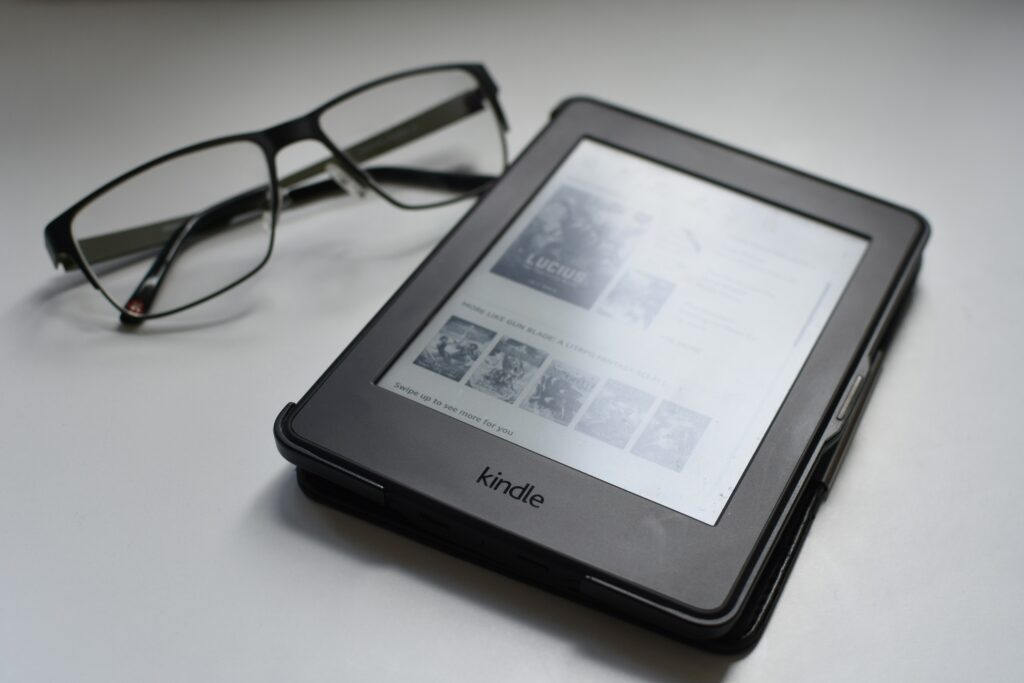Paperback VS Kindle
There has always been a huge debate on whether physical book copies are better than Kindle’s and I will say, the book community is divided. I personally prefer physical books, I can hold them in my hand and see what I’m doing.
That being said I do read faster when it comes to digital copies so that is the upside and they’re more portable than a stack of books. Kindle books are more cheap as well, but I never remember where I’ve left my glasses!
When it comes to books, I prefer physical copies but I don’t turn away from e-books if I have some to read. If you’re using a website such as NetGalley, you’ll need a device to read the books on.
Kindle vs. Paperback
With this age-old debate, you might be thinking, what’s better? Well here’s a summary which might help you pick between Kindle reading and physical copies. If you’re new to reading or you’re trying to make your mind up about a Kindle, this should help.
- Portability: A Kindle can store thousands of books, making it easy to carry a large library anywhere. Paperbacks are more limited in number but don’t rely on battery life.
- Cost: Kindle editions tend to be cheaper than paperback versions, especially for new releases and bestsellers.
- Reading Experience: Some readers prefer the tactile experience and the smell of paperbacks, while others enjoy the convenience and adjustable features of Kindle (e.g., font size, backlight).
- Environmental Impact: Kindles are considered more eco-friendly in the long term, as they reduce paper usage and shipping, though they do require materials for manufacturing.
- Convenience: Kindle editions are instantly accessible after purchase, while paperbacks require shipping or a trip to the store.
- Resale/Sharing: Paperbacks can be sold or shared with friends, while Kindle editions usually have restrictions on sharing.
- Weight and Comfort: Paperbacks are lightweight and easy to hold, but Kindles can be more comfortable for long reading sessions as they are thinner and lighter.
- Storage: With a Kindle, you can carry hundreds of books in a single device, while with paperbacks, you need physical storage space.
Paperback vs. Hardcover vs. Kindle
- Durability: Hardcovers are the most durable, making them ideal for collectors, while paperbacks are lighter and more affordable but can wear down easily. Kindle books are digital and can’t physically wear out.
- Price: Hardcovers are usually the most expensive, followed by paperbacks, while Kindle editions are typically the most affordable.
- Shelf Appeal: Hardcovers and paperbacks look great on bookshelves and are perfect for those who enjoy collecting physical books. Kindle books, on the other hand, save physical space.
Kindle Pros and Cons
Pros:
- Portability: Can store thousands of books in one lightweight device, making it easy to carry your entire library wherever you go.
- Customisation: Adjustable font size, backlighting, and text layout make reading comfortable, especially in different lighting conditions.
- Instant Access: Purchase and download books instantly without waiting for shipping or visiting a store.
- Eco-Friendly: Reduces the need for paper, ink, and transportation, making it more environmentally friendly in the long term.
Cons:
- Screen Fatigue: Extended reading on a digital screen might cause eye strain, though e-ink displays help reduce this.
- Battery Dependence: Kindles need to be charged, though battery life can last weeks. If it dies, you can’t read until recharged.
- Lack of Tangibility: Kindle lacks the tactile experience of flipping pages, which many readers cherish.
- DRM Restrictions: Books purchased on Kindle often have Digital Rights Management (DRM), meaning you can’t freely share or resell them.

Physical Books Pros and Cons
Pros:
- Tangible Experience: The feel, smell, and weight of a physical book provide a sensory experience many readers find comforting and nostalgic.
- No Battery Needed: Paper books don’t need charging and can be read anytime without worrying about running out of power.
- Collectible: Physical books can be displayed on shelves, gifted, and even passed down through generations.
- Easy to Share/Resell: You can easily lend or sell physical books to friends, family, or second-hand stores without restrictions.
Cons:
- Less Portable: Carrying multiple books, especially hardcovers, can be heavy and inconvenient compared to an e-reader.
- Environmental Impact: The production of physical books requires paper, ink, and transportation, which has a larger environmental footprint.
- Storage Space: Physical books take up room, and collecting too many can lead to clutter or require additional storage.
- Higher Costs: Physical books, particularly hardcovers, are usually more expensive than their digital counterparts.
Both formats have unique benefits, so the best choice often depends on personal preference and reading habits. Personally, I have my iPad with me when I travel and read books on that although when I’m at home my go to choice is a physical book that I can enjoy while eating biscuits.






